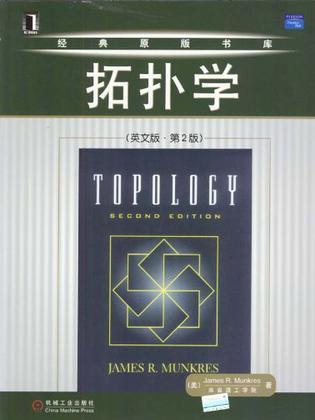目录
Preface
A Note to the Reader
Part I GENERAL TOPOLOGY
Chapter 1 Set Theory and Logic
1 Fundamental Concepts
2 Functions
3 Relations
4 The Integers and the Real Numbers
5 Cartesian Products
6 Finite Sets
7 Countable and Uncountable Sets
8 The Principle of Recursive Definition
9 Infinite Sets and the Axiom of Choice
10 Well-Ordered Sets
11 The Maximum Principle
Supplementary Exercises: Well-Ordering
Chapter 2 Topological Spaces and Continuous Functions
12 Topological Spaces
13 Basis for a Topology
14 The Order Topology
15 The Product Topology on X x Y
16 The Subspace Topology
17 Closed Sets and Limit Points
18 Continuous Functions
19 The Product Topology
20 The Metric Topology
21 The Metric Topology (continued)
*22 The Quotient Topology
*Supplementary Exercises: Topological Groups
Chapter 3 Connectedness and Compactness
23 Connected Spaces
24 Connected Subspaces of the Real Line
*25 Components and Local Connectedness
26 Compact Spaces
27 Compact Subspaces of the Real Line
28 Limit Point Compactness
29 Local Compactness
*Supplementary Exercises: Nets
Chapter 4 Countability and Separation Axioms
30 The Countability Axioms
31 The Separation Axioms
32 Normal Spaces
33 The Urysohn Lemma
34 The Urysohn Metrization Theorem
*35 The Tietze Extension Theorem
*36 Imbeddings of Manifolds
*Supplementary Exercises: Review of the Basics
Chapter 5 The Tychonoff Theorem
37 The Tychonoff Theorem
38 The Stone-Cech Compactification
Chapter 6 Metrization Theorems and Paracompactness
39 Local Finiteness
40 The Nagata-Smirnov Metrization Theorem
41 Paracompactness
42 The Smirnov Metrization Theorem
Chapter 7 Complete Metric Spaces and Function Spaces
43 Complete Metric Spaces
*44 A Space-Filling Curve
45 Compactness in Metric Spaces
46 Pointwise and Compact Convergence
47 Ascoli's Theorem
Chapter 8 Baire Spaces and Dimension Theory
48 Baire Spaces
*49 A Nowhere-Differentiable Function
50 Introduction to Dimension Theory
*Supplementary Exercises: Locally Euclidean Spaces
Part II ALGEBRAIC TOPOLOGY
Chapter 9 The Fundamental Group
51 Homotopy of Paths
52 The Fundamental Group
53 Covering Spaces
54 The Fundamental Group of the Circle
55 Retractions and Fixed Points
*56 The Fundamental Theorem of Algebra
*57 The Borsuk-Ulam Theorem
58 Deformation Retracts and Homotopy Type
59 The Fundamental Group of Sn
60 Fundamental Groups of Some Surfaces
Chapter 10 Separation Theorems in the Plane
61 The Jordan Separation Theorem
*62 Invariance of Domain
63 The Jordan Curve Theorem
64 Imbedding Graphs in the Plane
65 The Winding Number of a Simple Closed Curve
66 The Cauchy Integral Formula
Chapter 11 The Seifert-van Kampen Theorem
67 Direct Sums of Abelian Groups
68 Free Products of Groups
69 Free Groups
70 The Seifert-van Kampen Theorem
71 The Fundamental Group of a Wedge of Circles
72 Adjoining a Two-cell
73 The Fundamental Groups of the Torus and the Dunce Cap
Chapter 12 Classification of Surfaces
74 Fundamental Groups of Surfaces
75 Homology of Surfaces
76 Cutting and Pasting
77 The Classification Theorem
78 Constructing Compact Surfaces
Chapter 13 Classification of Covering Spaces
79 Equivalence of Covering Spaces
80 The Universal Covering Space
*81 Covering Transformations
82 Existence of Covering Spaces
*Supplementary Exercises: Topological Properties and
Chapter 14 Applications to Group Theory
83 Covering Spaces of a Graph
84 The Fundamental Group of a Graph
85 Subgroups of Free Groups
Bibliography
Index
【展开】
【收起】
内容简介
本书作者在拓扑学领域享有盛誉。
本书分为两个独立的部分;第一部分普通拓扑学,讲述点集拓扑学的内容;前4章作为拓扑学的引论,介绍作为核心题材的集合论、拓扑空间。连通性、紧性以及可数性和分离性公理;后4章是补充题材;第二部分代数拓扑学,讲述与拓扑学核心题材相关的主题,其中包括基本群和覆盖空间及其应用。
本书最大的特点在于对理论的清晰阐述和严谨证明,力求让读者能够充分理解。对于疑难的推理证明,将其分解为简化的步骤,不给读者留下疑惑。此外,书中还提供了大量练习,可以巩固加深学习的效果。严格的论证,清晰的条理、丰富的实例,让深奥的拓扑学变得轻松易学。
【展开】
【收起】
下载说明
1、追日是作者栎年创作的原创作品,下载链接均为网友上传的的网盘链接!
2、相识电子书提供优质免费的txt、pdf等下载链接,所有电子书均为完整版!
下载链接
热门评论
-
三甲大聪的评论从拓扑学的角度研究兰州拉面为什么好吃…现在学习数学的人都这么无聊了吗…[眼泪] 重庆·西南大学
-
厮嘉丽_Engineers的评论“莫比乌斯”是一个拓扑学概念用一个纸带旋转半圈再将两端黏上,会发现只有一个表面和一个边界。意喻着有些人总是不断地重复自己的错误,事件无止尽循环导致永远逃不出这个怪圈。
-
nanciis的评论“节点”一概念被应用于许多领域。节点,通常来说,是指局部的膨胀(像一个个绳结一样),亦或是一个交汇点。[1] 电力学中,节点是塔的若干部件的汇合点。机械工程学中,节点是在一对相啮合的齿轮上,其两节圆的切点。在网络拓扑学中,节点是网络任何支路的终端或网络中两个或更多支路的互连公共点。
-
被坑淹没不知所措的评论是不是项链在一起放久了也会缠在一起就像耳机线一样?能不能用拓扑学解释??傻逼玩意儿((((
-
女巫小玖的评论“莫比乌斯”是一个拓扑学概念,即用一个纸带旋转半圈再将两端黏上,会发现只有一个表面和一个边界。意喻着人总是不断地重复自己的错误,事件无止尽循环永远逃不出这个怪圈。片中也有涉及佛教以及宽恕的细节。据悉,电影以“莫比乌斯”命名,是对人困在痛苦中无止尽恶性循环的一种比喻。马克。
-
它日_的评论世界上为什么会有随机过程实变函数拓扑学这种东西呢……觉得前面考得三门,简直不算什么……
-
Z_世H的评论蝴蝶效应 (拓扑学连锁反应)(The Butterfly Effect)是指在一个动力系统中,初始条件下微小的变化能带动整个系统的长期的巨大的连锁反应。这是一种混沌现象。 第一部,最经典,正如男主爸爸说:你不能扮演上帝。 第二部,完全靠颜值。 第三部,开头血腥把我吓得退出来。
-
十七世纪的东明的评论拓扑学看得要吐了,发条微博冷静一下
-
DurianKil1Azure的评论我这种期末不考人解组胚高数电磁场国际法拓扑学的人 还是不解知足常乐的风情
-
ParadoxGestalt的评论网页链接 拓扑学在20世纪的出现,是作为一门统一几乎整个数学的学科,有点像哲学试图把一切知识协调起来一样。因为它的本原性,拓扑学成为绝大部分数学的基础,为数学提供了意想不到的凝聚性。 分享自Kindle
